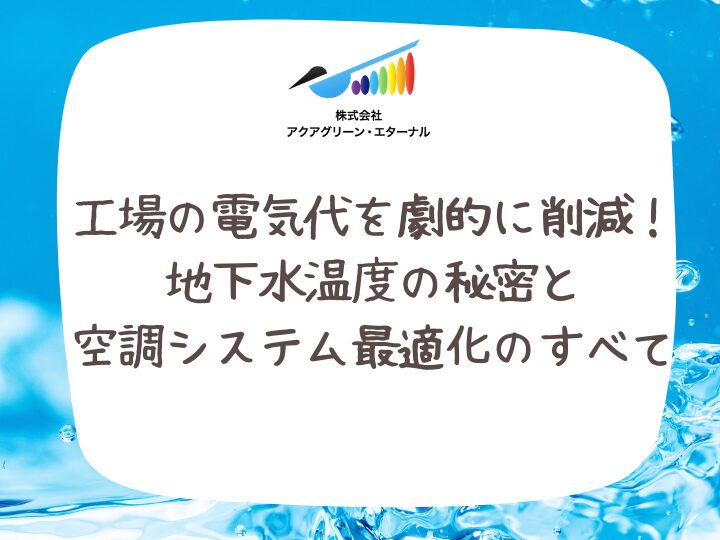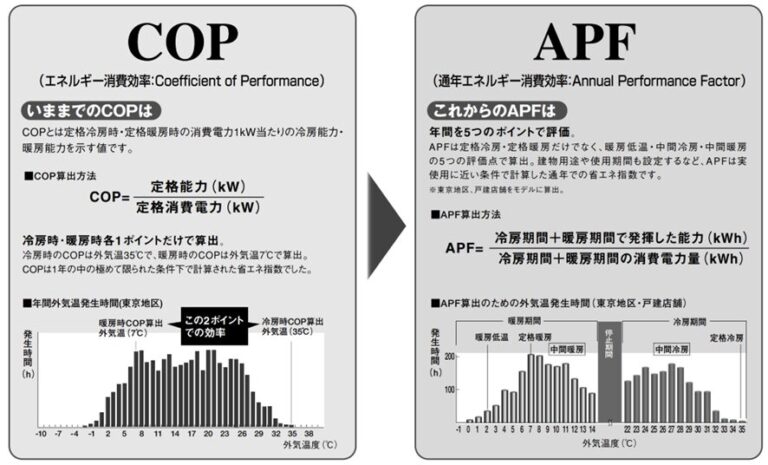Dramatically reduce your factory's electricity bill! The secrets of groundwater temperature and air conditioning system optimization
This article explains the impact of seasonal groundwater temperature fluctuations on the efficiency of factory air conditioning systems and how to deal with them. It provides a detailed explanation of groundwater temperature fluctuation patterns, their impact on air conditioning efficiency, system optimization strategies, environmental benefits and precautions, and the importance of temperature monitoring and prediction, and presents specific methods and benefits for efficient air conditioning operation.

Seasonal patterns of groundwater temperature
Seasonal fluctuations in groundwater temperature are an important factor that directly affect the efficiency of factory air conditioning systems. Generally, groundwater temperature fluctuates throughout the year, but the changes have a delay and buffering effect compared to changes in surface air temperature. Specifically, groundwater temperature often reaches its highest temperature about 2 to 3 months after midsummer, when the surface air temperature is at its highest. This is due to the thermal conductivity and specific heat capacity of the earth.
The range of fluctuation in groundwater temperature varies depending on the depth, and generally the greater the depth, the smaller the range of fluctuation. For example, at a depth of 10m, the annual temperature fluctuation range is about 2-3°C, whereas at a depth of 50m it may be almost constant (annual fluctuation range of less than 1°C). By understanding this characteristic and drawing groundwater from an appropriate depth, it may be possible to ensure cooling water with a more stable temperature.
Effect of groundwater temperature on air conditioning efficiency
The coefficient of performance (COP) of a water-cooled air conditioning system depends heavily on the cooling water temperature. For example, in a typical water-cooled chiller, the COP decreases by about 2 to 31 TP3T for every 1°C increase in cooling water temperature. In other words, if the groundwater temperature increases by 5°C in summer, the efficiency of the air conditioning system may decrease by 10 to 151 TP3T.
This decrease in efficiency directly leads to an increase in electricity consumption. If an annual cooling load of a factory is 1,000,000 kWh, and efficiency decreases by 10% due to an increase in groundwater temperature during the three summer months, an additional increase in electricity consumption of approximately 25,000 kWh is expected. Assuming the unit price of electricity is 20 yen/kWh, this will result in an annual cost increase of 500,000 yen.
Conversely, in winter, lower groundwater temperatures improve heating efficiency. If you are using a heat pump system, lower groundwater temperatures in winter lead to improved heating COP, which contributes to reduced energy consumption.
Optimization of air conditioning systems for groundwater temperature changes
Dynamic optimization of the system is essential to accommodate seasonal variations in groundwater temperature. Specific optimization strategies include:
1. Introduction of variable speed pumps: By optimizing the cooling water flow rate according to the groundwater temperature, it is possible to reduce pump power and improve heat exchange efficiency at the same time.
2. Increasing the size of the heat exchanger: In preparation for rising groundwater temperatures in summer, increasing the surface area of the heat exchanger can ensure sufficient heat exchange capacity even at high temperatures. However, it is necessary to consider the balance with the initial cost.
3. Use of a thermal storage system: By storing cold energy at night when the groundwater temperature is low and using it during the daytime when peak loads are present, the efficiency of the entire system can be improved.
4. Introduction of AI control: Using machine learning algorithms, past operating data and weather forecasts are analyzed to predict groundwater temperature and cooling load, and the optimal operating parameters are automatically adjusted based on this, ensuring highly efficient operation throughout the year.
5. Construction of a hybrid system: By using a geothermal heat exchange system and an air-cooled heat pump in combination, and selecting the optimal heat source in response to fluctuations in groundwater temperature, it is possible to maintain highly efficient operation throughout the year.
By appropriately combining these optimization strategies, it is possible to minimize the impact of seasonal variations in groundwater temperature and significantly improve the year-round energy efficiency of the air conditioning system.
Environmental benefits and considerations of using groundwater
Using groundwater for air conditioning is a very effective way to reduce the burden on the environment. Specifically, it has the following advantages:
1. Reduction of CO2 emissions: Compared to conventional air-cooled systems, the groundwater utilization system has the potential to reduce annual CO2 emissions by 30 to 501 TP3T. This directly contributes to the SDGs and improves the ESG evaluation of companies.
2. Mitigating the heat island effect: Unlike air-cooled systems, less heat is released into the atmosphere, helping to mitigate the heat island effect in urban areas.
3. Space saving: Since a cooling tower is no longer necessary, rooftop and site space can be utilized more effectively.
On the other hand, for the sustainable use of groundwater, attention should be paid to the following:
1. Setting an appropriate pumping rate: In order to prevent land subsidence and impacts on surrounding wells due to excessive pumping, an appropriate pumping rate must be set based on a hydrogeological survey. In general, it is recommended to keep the pumping rate below 501 TP3T of annual recharge.
2. Water quality monitoring: It is important to monitor changes in water quality (especially iron and hardness) over the long term and to carry out appropriate water treatment if necessary.
3. Groundwater return: Whenever possible, used groundwater should be returned to the ground, which will help maintain the groundwater level and ensure sustainable use.
4. Compliance with legal regulations: Some areas have regulations regarding the use of groundwater, so prior consultation with the relevant authorities is required.
By using groundwater while paying close attention to these points, it is possible to reduce the burden on the environment and operate a sustainable business.
Importance of groundwater temperature monitoring and prediction
For efficient air conditioning operation, it is essential to build a highly accurate groundwater temperature monitoring and prediction system. The specific methods and benefits are as follows:
1. Real-time monitoring system:
– High-precision temperature sensors (accuracy of ±0.1°C or better) installed at multiple depths
- Automatic recording using a data logger (every 5 minutes to 1 hour)
– Real-time monitoring with cloud-based data management system
2. Building a predictive model:
– Time series analysis using past data (ARIMA model, etc.)
– Machine learning models (random forests, neural networks, etc.) that use meteorological data, geological data, pumping volume data, etc. as input
– Numerical simulation model (groundwater flow and heat transport analysis using finite element method)
3. Improved prediction accuracy:
– Periodically retrain and update the model
– Integrating multiple models through ensemble learning
– Real-time data processing and prediction updates using edge computing
Implementing such a system provides several tangible benefits:
1. Improved operating efficiency: By pre-setting optimal operating parameters based on predicted groundwater temperature, annual energy efficiency can be improved by 5-101 TP3T.
2. Cost reduction: In addition to direct reductions in electricity costs through improved efficiency, preventive maintenance can also be expected to reduce equipment maintenance costs. Annual operating costs can potentially be reduced by 3 to 71 TP3T.
3. Optimization of capital investment: Understanding the long-term temperature fluctuation trend can optimize future equipment renewal and expansion plans. For example, if the future groundwater temperature is predicted to rise, the margin of the heat exchanger can be appropriately set.
4. Improved risk management: Early detection of abnormal changes in temperature or water quality and the appropriate countermeasures can be taken to ensure stable operation of the system and reduce risks.
5. Use in environmental reporting: Energy saving effects can be quantified based on precise data, which can be used in CSR and ESG reports.
Although an initial investment cost is required, taking into account these benefits, the investment can be recovered in about 3 to 5 years, and it has the potential to bring about significant economic benefits in the long term. Factory managers and managers should view such monitoring and prediction systems as a strategic investment and actively consider introducing them.



